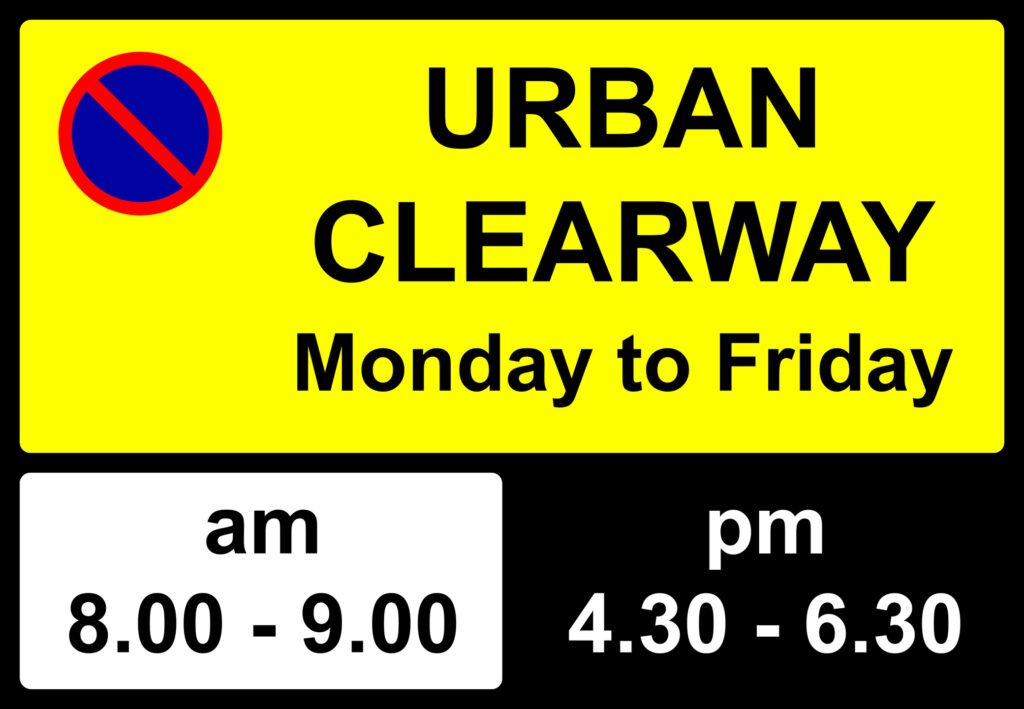
Urban Clearway are one of those road signs that can trip learners up because they look simple, but the rules are quite specific. Understanding them is essential if you want to avoid confusion, fines, or faults on your driving test.
The Sign
An Urban Clearway sign looks like this:
- A blue circle with a red border and a single red diagonal line (the same symbol as “No Waiting”).
- Beneath it, there’s usually a time plate showing the hours of operation, such as “Mon–Fri 7–9:30 am, 4–6 pm”.

What It Means
During the times shown on the sign:
- You must not stop or wait on the main carriageway — not even to pick up or drop off passengers.
- You may only stop briefly to set down or pick up passengers, provided it doesn’t delay other traffic.
Outside the hours of restriction, the road is treated as normal — unless there are other markings (such as yellow lines) that impose their own rules.

Where You’ll See Them
Urban Clearways are usually placed on busy roads in towns and cities, often during rush hours. The aim is to:
- Keep traffic flowing smoothly.
- Prevent congestion caused by parked or waiting vehicles.
- Ensure busier stretches of road don’t become bottlenecks.
Key Points for Learner Drivers
- Check the time plate carefully. The restriction only applies during the times shown.
- Stopping is only allowed for as long as it takes to pick up or set down passengers. Anything more is prohibited.
- Don’t confuse it with a Clearway.
- Urban Clearway = applies only at certain times, and short stops for passengers are allowed.
- Clearway = applies 24 hours a day, and no stopping at all is permitted except in an emergency.
Penalties
Stopping illegally on an Urban Clearway could lead to:
- A Penalty Charge Notice (fine).
- Being marked down on your driving test if you show a lack of awareness.
Final Word
Think of an Urban Clearway as a road’s way of saying: “Keep moving during the busy hours. Don’t use this road as a waiting area.”
If you remember that short passenger stops are the only exception, and you always check the time plate, you’ll handle them with confidence both on the test and in real-world driving.
What penalties might I face for illegally stopping on an Urban Clearway?
Illegally stopping on an Urban Clearway can result in a Penalty Charge Notice, which is a fine, and may also be marked down on your driving test if your lack of awareness is demonstrated.
What are the key points learner drivers should remember about Urban Clearways?
Learner drivers should carefully check the time plate to understand when restrictions are in place, only stop briefly to pick up or set down passengers, and not confuse Urban Clearways with Clearways, which have different rules.
In what locations are Urban Clearways typically found and what is their purpose?
Urban Clearways are usually found on busy roads in towns and cities during rush hours, and their purpose is to keep traffic flowing smoothly, prevent congestion caused by parked or waiting vehicles, and avoid road bottlenecks.
What restrictions apply during the hours shown on the Urban Clearway sign?
During the hours indicated, you must not stop or wait on the main carriageway, except for brief stops to pick up or set down passengers, and only if it does not delay other traffic.
What is an Urban Clearway and how do I recognize it?
An Urban Clearway is a traffic regulation identified by a blue circle sign with a red border and a single red diagonal line, indicating no stopping or waiting during specified times, which are shown on a time plate beneath the sign.
Contents
- 1 The Sign
- 2 What It Means
- 3 Where You’ll See Them
- 4 Key Points for Learner Drivers
- 5 Penalties
- 6 Final Word
- 6.1 What penalties might I face for illegally stopping on an Urban Clearway?
- 6.2 What are the key points learner drivers should remember about Urban Clearways?
- 6.3 In what locations are Urban Clearways typically found and what is their purpose?
- 6.4 What restrictions apply during the hours shown on the Urban Clearway sign?
- 6.5 What is an Urban Clearway and how do I recognize it?